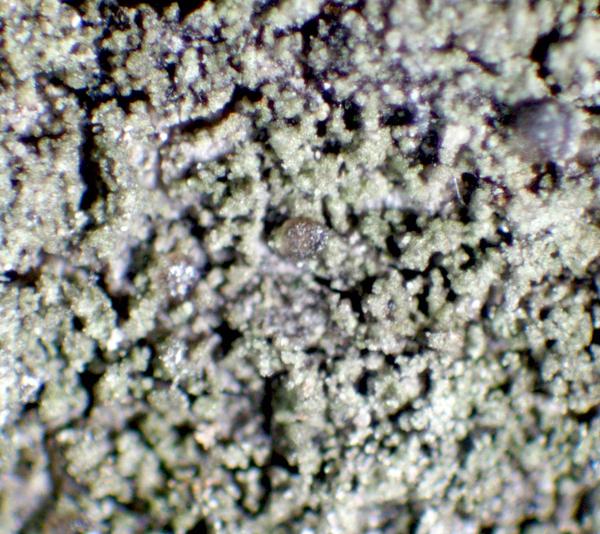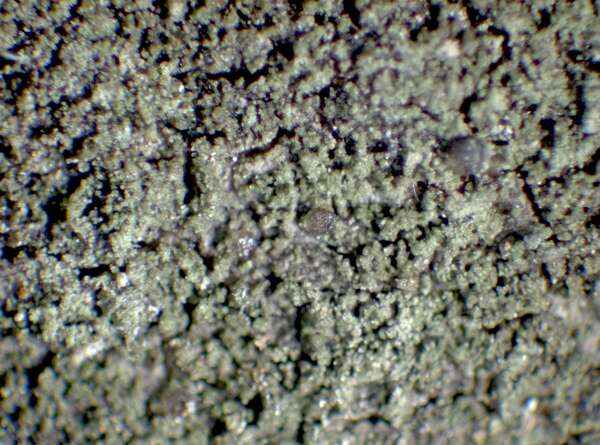Scoliciosporum gallurae Vězda & Poelt
in Nimis & Poelt, Studia Geobot., 7, suppl. 1: 221, 1987.
Synonyms:
Distribution: C - Tosc (TSB 31214), Marc (Nimis & Tretiach 1999), Laz (Fornasier & al. 2005), Sar (Zedda 2002).
Description: Thallus subleprose, episubstratic, green to yellowish green, usually forming up to a few mm wide, more or less continuous, rounded patches, sorediate, without a distinct prothallus. Soredia diffuse, up to 25 μm thick, with a distinct wall, often gathered into irregularly rounded to elongate, up to 100 μm thick consoredia mixed with clusters of more or less free algal cells with no evident hyphal envelope. Apothecia biatorine, sessile, scattered to contiguous, pale to dark brown, almost flat to slightly convex, up to 0.2(-0.3) mm across, soon immarginate. Proper exciple of radiating, branched and anastomosed hyphae; epithecium brown, K-, N-, rarely with a greenish tinge and then K-, N+ purple; hymenium colourless, I+ blue; paraphyses c. 1.5 μm thick, strongly branched and anastomosing up to the upper part, immersed in a gelatinous matrix and resembling excipular hyphae; hypothecium colourless. Asci 8-spored, broadly clavate, surrounded by a gelatinous, amyloid sheet, with a well-developed, amyloid tholus containing a widely cylindrical axial body and a poorly developed, bluntly conical ocular chamber, more or less Lecanora-type. Ascospores (0-)3-septate, fusiform, straight to slightly curved, (12-)15-22(-24) x 2.5-3.5(-4) μm. Photobiont chlorococcoid, the cells up to 16 μm wide. Spot tests: thallus K-, C-, KC-, P- or soredia fleeting C+ red (reaction often visible in squash preparations only). Chemistry: thallus with traces of gyrophoric acid.Note: on twigs and branches, more rarely on trunks of coniferous and broad-leaved trees at relatively low elevations; quite common in southern Europe, being often sterile it has been frequently overlooked, and is probably much more widespread, especially in Tyrrhenian Italy.
Growth form: Crustose
Substrata: bark
Photobiont: green algae other than Trentepohlia
Reproductive strategy: mainly sexual
Most common in areas with a humid-warm climate (e.g. most of Tyrrenian Italy)
Commonnes-rarity: (info)
Alpine belt: absent
Subalpine belt: absent
Oromediterranean belt: absent
Montane belt: absent
Submediterranean belt: very rare
Padanian area: extremely rare
Humid submediterranean belt: rather rare
Humid mediterranean belt: rare
Dry mediterranean belt: extremely rare

Predictive model
Herbarium samples
Growth form: Crustose
Substrata: bark
Photobiont: green algae other than Trentepohlia
Reproductive strategy: mainly sexual
Most common in areas with a humid-warm climate (e.g. most of Tyrrenian Italy)
Commonnes-rarity: (info)
Alpine belt: absent
Subalpine belt: absent
Oromediterranean belt: absent
Montane belt: absent
Submediterranean belt: very rare
Padanian area: extremely rare
Humid submediterranean belt: rather rare
Humid mediterranean belt: rare
Dry mediterranean belt: extremely rare

Predictive model
| Herbarium samples |
 INDEX FUNGORUM
INDEX FUNGORUM
 GBIF
GBIF





